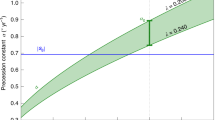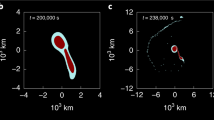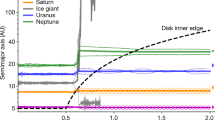Abstract
The origin of the spin-axis orientations (obliquities) of the giant planets is a fundamental issue because if the obliquities resulted from tangential collisions with primordial Earth-sized protoplanets, then they are related to the masses of the largest planetesimals out of which the planets form1,2,3,4,5,6,7. A problem with this mechanism, however, is that the orbital planes of regular satellites would probably be uncorrelated with the obliquities, contrary to observations6,7. Alternatively, they could have come from an external twist that affected the orientation of the Solar System plane2; but in this model, the outer planets must have formed too rapidly, before the event that produced the twist8. Moreover, the model cannot be quantitatively tested. Here I show that the present obliquities of the giant planets were probably achieved when Jupiter and Saturn crossed the 1:2 orbital resonance9 during a specific migration process: different migration scenarios cannot account for the large observed obliquities. The existence of the regular satellites of the giant planets does not represent a problem in this model because, although they formed soon after the planetary formation, they can follow the slow evolution of the equatorial plane it produces.
This is a preview of subscription content, access via your institution
Access options
Subscribe to this journal
Receive 51 print issues and online access
$199.00 per year
only $3.90 per issue
Buy this article
- Purchase on Springer Link
- Instant access to full article PDF
Prices may be subject to local taxes which are calculated during checkout


Similar content being viewed by others
References
Safronov, V. S. Evolution of the Protoplanetary Cloud and Formation of The Earth and the Planets Ch 10, 113–135 (NASA, 1969)
Tremaine, S. On the origin of the obliquities of the outer planets. Icarus 89, 85–92 (1991)
Dones, L. & Tremaine, S. On the origin of planetary spins. Icarus 103, 67–92 (1993)
Lissauer, J. J., Berman, A. F., Greenzweig, Y. & Kary, D. M. Accretion of mass and spin angular momentum by a planet on an eccentric orbit. Icarus 127, 65–92 (1997)
Lissauer, J. J. & Kary, D. M. The origin of the systematic component of planetary rotation. Icarus 94, 126–159 (1991)
Lissauer, J. J. & Safronov, V. S. The random component of planetary rotation. Icarus 93, 288–297 (1991)
Brunini, A. A possible constraint to Uranus' great collision. Planet. Space Sci. 43, 1019–1021 (1995)
Ward, W. & Hamilton, D. P. Tilting Saturn I. Analytic model. Astron. J. 128, 2501–2509 (2004)
Tsiganis, K., Gomes, R., Morbidelli, A. & Levison, H. F. Origin of the orbital architecture of the giant planets of the Solar System. Nature 435, 459–461 (2005)
Korycansky, D. G., Bodenheimer, P., Cassen, P. & Pollak, J. B. One-dimensional calculations of a large impact on Uranus. Icarus 84, 528–541 (1990)
Parisi, M. G. & Brunini, A. Constraints to Uranus' great collision. II. Planet. Space Sci. 45, 181–187 (1997)
Laskar, J. & Robutel, P. The chaotic obliquity of the planets. Nature 361, 608–612 (1993)
Fernández, J. A. & Ip, W.-H. Some dynamical aspects of the accretion of Uranus and Neptune—The exchange of orbital angular momentum with planetesimals. Icarus 58, 109–120 (1984)
Malhotra, R. The origin of Pluto's peculiar orbit. Nature 365, 819–821 (1993)
Ward, W. R. On disk–planet interactions and orbital eccentricities. Icarus 73, 330–348 (1988)
Artymowicz, P. Disk–satellite interaction via density waves and the eccentricity evolution of bodies embedded in disks. Astrophys. J. 419, 166–180 (1993)
Gomes, R., Levison, H. F., Tsiganis, K. & Morbidelli, A. Origin of the cataclysmic Late Heavy Bombardment period of the terrestrial planets. Nature 435, 466–469 (2005)
Miki, S. The gaseous flow around a protoplanet in the primitive solar nebula. Prog. Theor. Phys. 67, 1053–1067 (1982)
Colombo, G. & Franklin, F. A. On the formation of the outer satellite groups of Jupiter. Icarus 15, 186–189 (1971)
Goldreich, P. Inclination of satellite orbits about an oblate precessing planet. Astron. J. 70, 5–9 (1965)
Petit, J.-M., Morbidelli, A. & Valsecchi, G. B. Large scattered planetesimals and the excitation of the small body belts. Icarus 141, 367–387 (1999)
Thommes, E. W., Duncan, M. J. & Levison, H. F. Oligarchic growth of giant planets. Icarus 161, 431–455 (2003)
Press, W. H., Flannery, B. P., Teukolsky, S. A. & Vetterling, W. T. Numerical Recipes: The Art of Scientific Computing Ch 16, 718–726 (Cambridge Univ. Press, New York, 1989)
Acknowledgements
We acknowledge the support of IALP and ANPCyT.
Author information
Authors and Affiliations
Corresponding author
Ethics declarations
Competing interests
Reprints and permissions information is available at npg.nature.com/reprintsandpermissions. The author declares no competing financial interests.
Supplementary information
Supplementary Notes
This file contains Supplementary Methods and Supplementary Figure 1. (PDF 71 kb)
Rights and permissions
About this article
Cite this article
Brunini, A. Origin of the obliquities of the giant planets in mutual interactions in the early Solar System. Nature 440, 1163–1165 (2006). https://doi.org/10.1038/nature04577
Received:
Accepted:
Issue Date:
DOI: https://doi.org/10.1038/nature04577
This article is cited by
-
Astrophysics in 2006
Space Science Reviews (2007)
-
A common mass scaling for satellite systems of gaseous planets
Nature (2006)
-
Correction: Origin of the obliquities of the giant planets in mutual interactions in the early Solar System
Nature (2006)
Comments
By submitting a comment you agree to abide by our Terms and Community Guidelines. If you find something abusive or that does not comply with our terms or guidelines please flag it as inappropriate.



